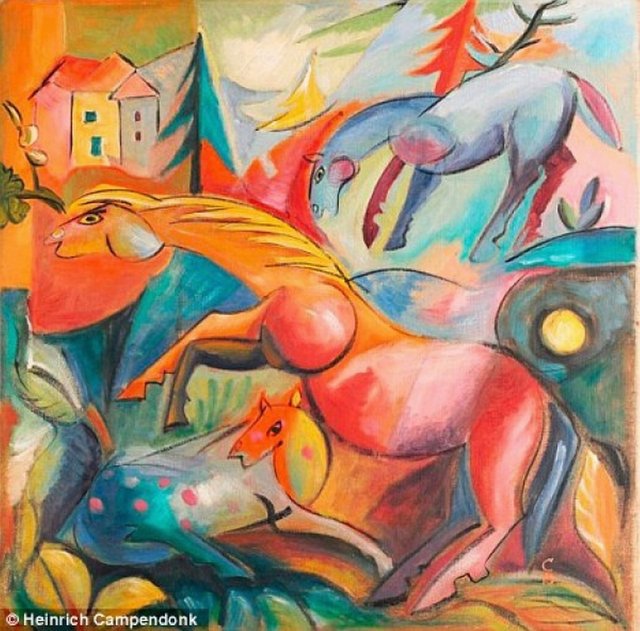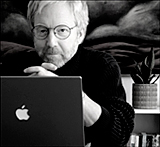Art forgeries snare unwary at online auction sites
By Stephen Brookes • The Washington Times • June 7, 2011
Steve Martin knows his art. The Hollywood star is an experienced, savvy collector and is so familiar with the art world that he even wrote a novel - “An Object of Beauty” - about it. So when Mr. Martin had the chance in 2004 to buy a painting by the early 20th-century expressionist painter Heinrich Campendonk for the bargain price of about $850,000, he jumped on it.
 Heinrich Campendonk’s “Landscape With Horses” Bad move. The painting, it turns out, was a forgery - a counterfeit so flawless that even an expert hired to authenticate it had been fooled. Mr. Martin wasn’t the only victim; police say the gang may have sold at least 14 forgeries over the past decade, defrauding galleries and collectors of close to $50 million.
Heinrich Campendonk’s “Landscape With Horses” Bad move. The painting, it turns out, was a forgery - a counterfeit so flawless that even an expert hired to authenticate it had been fooled. Mr. Martin wasn’t the only victim; police say the gang may have sold at least 14 forgeries over the past decade, defrauding galleries and collectors of close to $50 million.
But forgery isn’t just a problem for those in the stratosphere of the art world. Almost anyone can be a victim now, as fakes priced from a few hundred to several thousand dollars regularly show up in auctions, websites and galleries. Over the past 15 years, specialists say, the explosion of new ways to buy art online - particularly through auction sites such as eBay - has brought flocks of inexperienced buyers into the market and made it easier for counterfeiters to find them, fool them, fleece them and forget them.
“It’s pervasive,” said Alan Bamberger, author of “The Art of Buying Art” and a specialist in online art crime. “Twenty years ago, forgers operated on local or regional levels through auction houses that didn’t have art specialists on hand. But these days you can go online and show your masterworks to the world with no problem.”
Fakes make up a small percentage of all available art, Mr. Bamberger said, but it’s still a concern at small auctions and retail shops and a “substantial” problem online. With about 1.5 million works of art at any time on eBay alone, the online auction world is a huge and largely unregulated place where artists, reputable dealers, private sellers and con artists rub shoulders without really meeting.
Most of the art sold is genuine, and bona fide bargains can be found. Authentic works often go for a fraction of their price in bricks-and-mortar galleries, but the fantasy of finding an overlooked treasure - the Degas drawing someone found in the attic and is selling for pennies - still draws in the unwary, and forgers are ready to exploit the demand.
“EBay is a great place to buy fake art,” says Mr. Bamberger, who keeps files of suspicious online sales on his website, ArtBusiness.com. Among the questionable pieces: an alleged Picasso that went for $15,000, a purported Willem de Kooning that reached $17,500 and a watercolor said to be by Pierre Bonnard for $1,237 - all priced well below market value, all lacking documentation, and all almost certainly fake.
“The people who buy this stuff are just as much at fault” as the forgers, Mr. Bamberger said. “If you’re going to go online and beat the bushes for bargains, and you don’t know what you’re looking at, then you’re leaving yourself open to becoming a victim.”
There’s no dearth of crude, easy-to-spot fakes, but others are surprisingly sophisticated. In 2008, Spanish police and the FBI broke up an international ring that sold - mostly on eBay - about $5 million in near-perfect fakes of popular artists including Andy Warhol and Marc Chagall. Other forgers work on a smaller scale by finding paintings in secondhand shops that resemble those by famous artists, then changing signatures, adding antique frames, putting stickers and inscriptions on the backs of canvases, and sometimes adding layers of dust for authenticity.
Although selling forgeries is illegal and auction sites have rules against it, it’s really up to buyers to protect themselves. Mr. Bamberger advises bidders to get as much information from the seller as they can about the origins and background of a piece, and never assume that a piece is genuine just because it is signed - or that they’re the only one who has spotted a bargain. Ask for detailed photos, be suspicious about “Certificates of Authenticity” (they rarely mean much), make sure you have a money-back guarantee, never pay with money orders or wire transfers, and - especially when bidding on high-ticket items - consult with an expert before you bid.
To avoid getting burned, Mr. Bamberger says, it’s best to stick to established galleries and auction houses, where you can get your money back if the piece turns out to be counterfeit. If you must buy art online, educate yourself first.
“If you don’t know what you’re looking at at auction, don’t buy it,” he says. “You have to know what you’re doing, you have to understand art language, you have to know how to pick through a description, you have to know what questions to ask.”
Most of all: Don’t be too trusting. “A skeptical approach,” Mr. Bamberger said drily, “is very healthy.”


Reader Comments